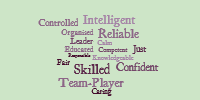Possible Variables:
- Wing Length
- Weight
- Card Thickness
- Size of Spinner
- Varying Wings
- Height Dropped
Possible Observations:
- Speed
- Number of Spins
- Duration of Spins
My Question
When I change CARD THICKNESS, what will happen to the SPEED at which the spinner falls?
My Prediction
The spinner with the thicker card will fall faster than the thinner spinner.
To make this a controlled experiment we created two spinners of equal size and equal wing length but one spinner was made out of paper whilst the other was created out of thick card. Once we had created our spinners and ensured that the only difference was the card thickness we began the experiment. To ensure the experiment was fair we made sure we were dropping both spinners from an equal height by measuring 2 meters from the ground. We then dropped the spinners and timed their drop time. We did this twice to ensure our results were reliable, we made sure that the same people dropped the spinners both times to keep the experiment controlled.
After we had conducted the experiment we calculated the results. To do this we added the two times for each spinner together and divided the result by two to find the average fall time.
The results showed that the thicker spinner fell in 3.43 seconds, whilst the thinner spinner took 4.45 seconds to fall showing that the thinner spinner took 1.02 seconds longer to fall than the thicker one. This result shows that the initial prediction was correct.



